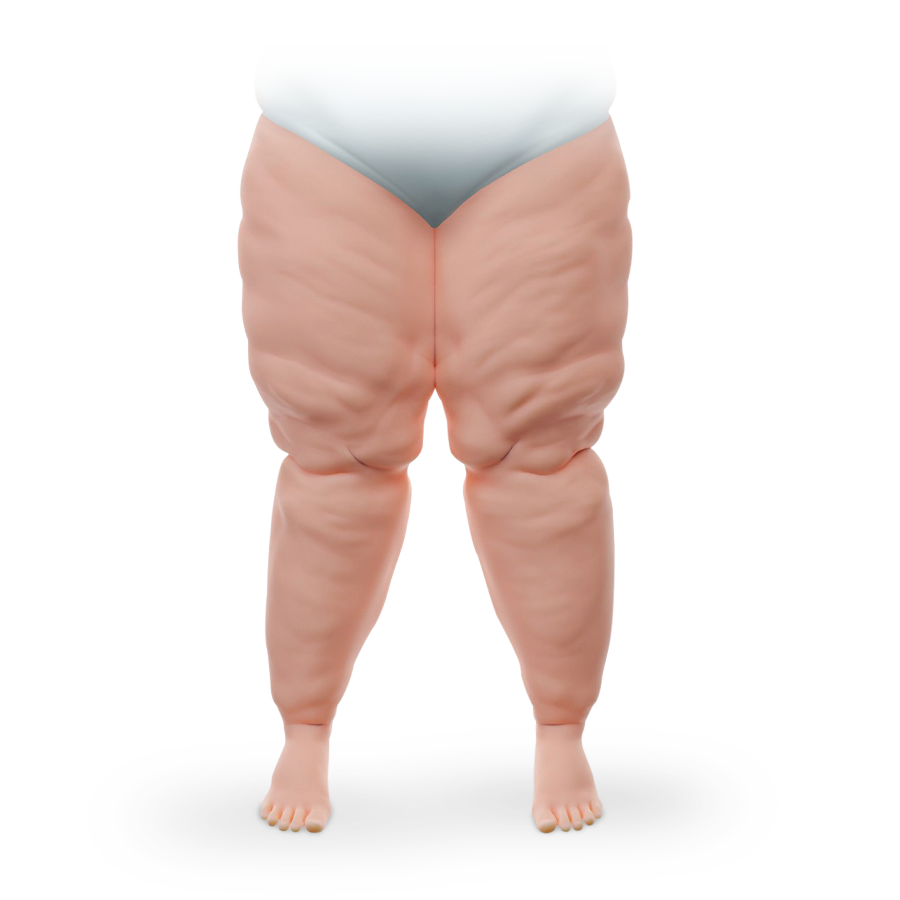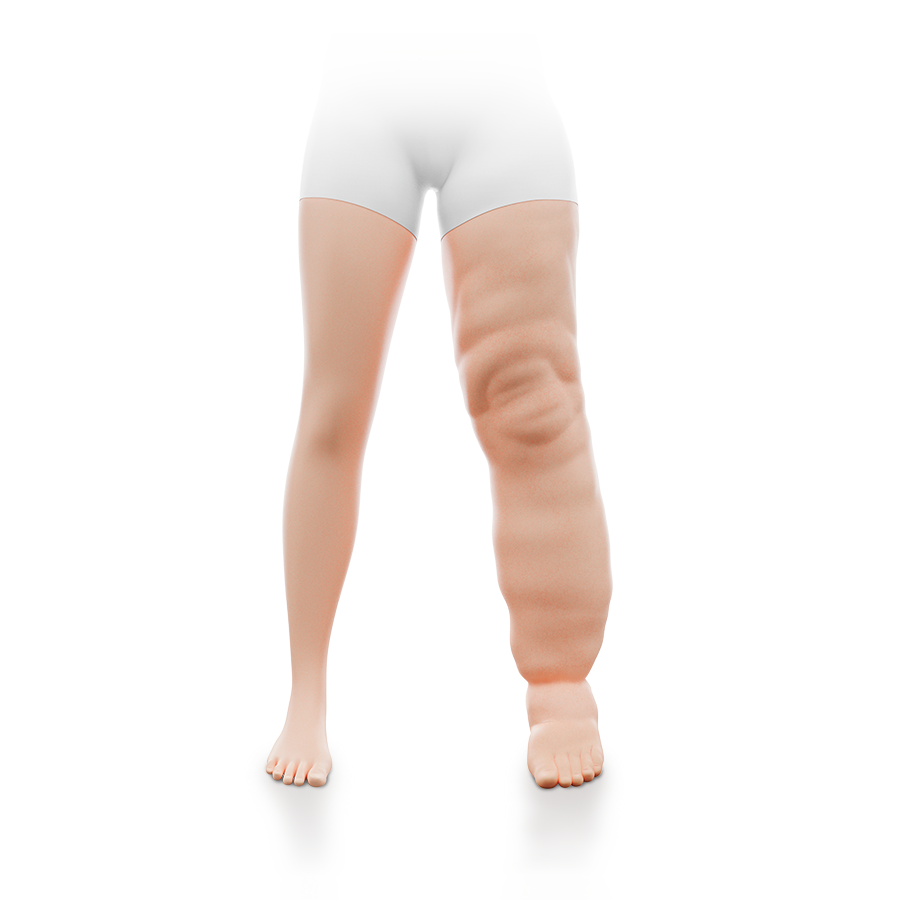The following information does not replace a physician’s diagnosis and advice under any circumstances whatsoever.
Lipoedema
Lipoedema: What's that?
The outward appearance of a person can have various causes. Strong thighs are often associated with excess weight, but that is not always the case. In some cases, a medical indication called lipoedema can be responsible for this appearance. The lipoedema is a disease which can occur independent of dietary habits or physical activity and is characterised by uneven fat distribution.
This uneven fat distribution causes swelling and uncontrolled deformation of the parts of the body affected, generally the legs or sometimes also the arms (approx. 30 %). It is important to take different possible causes of body shapes into account and avoid premature conclusions.
In case of lipoedema, the fatty tissue cells in the subcutaneous tissue (also referred to as adipocytes) multiply pathologically.
Pathological skin structure

Physiological skin structure

As women tend to have a higher fatty tissue ratio than men, they are also more frequently affected. Moreover, the female sex hormone oestrogen causes favourable development factors. It is estimated that worldwide, up to 10% of women are more or less significantly affected by this.
Due to the outward appearance, persons affected frequently suffer shame and a lack of self-esteem. Stereotyping and insufficient public awareness are also responsible for this. Lipoedema patients are often compared with obese persons.
With reference to the lipoedema, unhealthy nutrition and a lack of exercise are absolutely non-causal for the emergence of this appearance.
The 4 myths of the lipoedema
Myth 1: Classification in stages provides information regarding the severity of the illness.
For a long time, the following was deemed valid: The higher the stage, the worse the illness. However, the latest scientific knowledge from the AWMF Guideline 2024 shows: The classification in stages only describes structural changes to the tissue, but not the individual burden or pain intensity.
The good news: Personal perception counts! Complaints are individual.
Myth 2: The lipoedema is an oedema.
To-date, common belief was that tenderness and the feeling of tension were caused by fluid retention. However, this could not be confirmed by modern examination methods – so it is not actually a classical oedema.
The good news: With this, research is taking a further step forward to decipher the actual causes of lipoedema in a targeted manner and develop better treatment strategies.
Myth 3: The lipoedema is a progredient (progressive) illness.
Many persons concerned fear inevitable worsening. However, the current scientific data situation shows: The lipoedema does not automatically develop further. Whether and to what extent changes occur depends individually on various factors.
The good news: Persons affected can exercise more influence than they may think. An active lifestyle, targeted therapy and individual support can influence the course positively.
Myth 4: The lipoedema causes a lymphoedema.
The notion that the lipoedema automatically implies a lymphedema, could equally not be confirmed scientifically. Although some persons affected can also develop a lymphedema, the lipoedema is not the sole cause.
The good news: If you have a lipoedema, you need not necessarily have to deal with a lymphoedema. And, should both occur, effective treatment options exist.
The knowledge originates from the latest AWMF SK2 Guidelines and reflects the current state-of-the-art
Lipoedema causes
The cause of the fat maldistribution has not yet been fully clarified (idiopathic). A hormonal change phase and/or genetic predisposition can be recognised in several cases.
- Hormonal change, e.g. during puberty, pregnancy or the menopause
- Family predisposition
- Damage to the liver and possible related disturbance of the hormone household
Lipoedema symptoms
Increase in girth due to increased fatty tissue, frequently on the thighs and lower legs, partially also on the arms.
The appearance of the left-hand and right-hand extremities is mostly affected symmetrically.
The following symptoms can be incurred in connection with a lipoedema:
- Leading symptom pain
- Contact pain/Pressure pain
- Feeling of tension on the extremities affected
- Visible, symmetrical deformation of parts of the body due to fat deposits
- Proportion differences between the hip/thigh and the upper body
- The feet, hands and torso are generally not affected
- Heavy, pressure-sensitive legs
- Susceptibility to hematomas (bruise tendency)
The pain originates from a defensive inflammation reaction of the body to increased fat deposits
Characteristics of a lipoedema

- The skin has a smooth surface
- and the fatty tissue in the subcutaneous tissue is uniform and visibly finely nodular

- The skin surface is uneven and wavelike
- The fat structure appears to be coarsely nodular.

- The tissue is extensively deformed, the skin surface has dents.
- The circumference has increased substantially with overhanging skin flaps (dewlaps).
Lipoedema diagnosis
In particular, during the initial phase, it is difficult to recognise the ailment and to distinguish it from obesity (severe excess weight). Therefore, it is often only diagnosed late. If the swelling remains despite diet and a healthier lifestyle, this shows that it is likely a lipoedema.
In addition to general case history (questioning regarding patient history) the treating physician will pose questions relating to the typical complaints (see symptoms, e.g. pain).
During the physical examination, the examiner observes any existing symmetrical circumferential increase of the legs or also the arms.
If no pain symptoms exist, it is generally assumed that no lipoedema exists.
The appearance can be similar to a lymphoedema’s. This can be distinguished, for example, by the features listed below.
Lipoedema |
Lymphoedema
|
|
|---|---|---|
| Stemmer sign | x | ✓ |
| Skin dent test (Pittingödem) |
x | ✓ |
| Pressure pain | ✓ | x |
| Symmetry | ✓ | x |
| Inclination to hematoma | ✓ | x |
| Back of the foot/hand affected | x (not normally) |
✓ (possible) |
Lipoedema therapy
Conservative therapy:
Wearing medical compression stockings is a component of Complex Physical Decongestion Therapy (CPDT), which is used as a proven treatment method for oedema ailments. It consists of five modules which are applied in two stages.
For lipoedema, treatment is targeted at pain relief via compression.
Lipoedema are not curable, a diet and sports activity alone cannot break down the lipoedema fat. Nonetheless, general excess weight or obesity can strengthen lipoedema symptoms. Even if a lack of exercise and unhealthy nutrition do not trigger the lipoedema, it is constructive for your own body to maintain a healthy lifestyle. Clarification regarding healthy nutrition and appropriate exercise should also always be provided.
If psychic anomalies (such as depression) are incurred due to the illness, psychotherapy may also be applied. Furthermore, support groups exist for affected persons where they can seek help.
Operative therapy:
In some cases where conservative therapy achieves no or little improvement, the treating physician can propose operative therapy.
Liposuction (lipectomy) does not heal the underlying disease, but can restore the patient’s quality of life and mobility. Surgical intervention for obesity such as a gastric band or gastric sleeve can provide lipoedema symptom relief.
Prevention of lipoedema
As the cause has not been finally clarified and hormonal change within the body is frequently viewed as causal, it is difficult to find preventive measures. However, risk factors/body conditions exist which are incurred more frequently amongst lipoedema patients and can reinforce the symptoms. They include, for example, excess weight.
In general, healthy nutrition and appropriate sports activity can relieve the symptoms of a lipoedema.
BORT AktiVen® Intense
Medical compression stockings
A large number of individual versions for leg, hand and toe care excel with their top manufacturing quality. Available in different versions as well as standard and trend colours, they are an attractive and medically effective accompaniment for oedema therapy.
Daily wearing for relief you can feel
In order to generate the best possible therapeutic success, medical compression stockings should be put on daily after getting up and be worn until the evening during the maintenance stage.
The stockings are adapted individually to the legs, arms or hands and are therefore very comfortable to wear.



